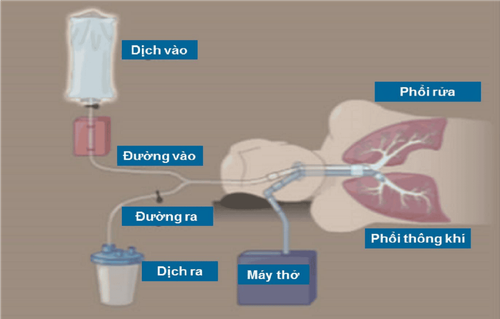This is an automatically translated article.
Breathing when running is very important because it determines how far the practitioner can run, how fast he can run. Knowing the correct breathing technique during endurance running will help you reduce fatigue and improve your performance.
1. Why should you pay attention to your breathing when running?
In the process of exercising, if you do not know how to breathe, the training session will become less effective. The technique of endurance running is similar. While running, the force exerted on the legs will be 2-3 times the body weight. This force will be stronger if you land and exhale at the same time. This is because when you exhale, the diaphragm and abdominal muscles will relax, balancing the body. Therefore, if you know how to breathe properly when running endurance, you will create a uniform impact on both legs, avoid putting force on one leg continuously, reducing the risk of injury.
2. How to apply breathing while running?
2.1 About breathing rate
When running endurance, you need to breathe evenly. Regular breathing is rhythmic breathing. There are many different breathing rates for each person. In which, the most common is the 3:2 breathing rate. That means 3 inhalations, 2 exhalations following the running footsteps. You will run 5 steps equivalent to 1 exhalation - inhalation. Practice a lot to form a habit that will help you breathe when jogging naturally in accordance with this breathing rhythm.
If you feel that breathing according to your footsteps is too difficult, you can mentally repeat the breathing rhythms in your head (count from 1 to 3, then inhale, count from 1 to 2, then exhale). Breathing will be effective if you take in as much oxygen as possible and expel as much CO2, preparing for the next oxygen load.
You can refer to the breaths when running as follows:
Warm-up: 3:2 breathing (3 inhalations - 2 exhalations); When running fast: Breathing rate 2:1 (2 inhalations - 1 exhale); When sprinting: Breathing rate 2:1:1:1 (including 2 inhalations - 1 exhalation - 1 inhalation - 1 exhalation).

Bạn cần hít thở đều khi chạy bền
2.2 Belly breathing
According to many experts who teach breathing during endurance running, you can apply the abdominal breathing method. Belly breathing helps to optimize the amount of oxygen brought into the body with each breath than breathing through the chest (a habit of many people).
Practice abdominal breathing as follows: You lie on your back, keeping your chest and shoulders fixed. Then, focus on feeling your belly rise when you inhale, your belly fall when you exhale, remembering to breathe through both your nose and mouth.
2.3 Breathing tips for endurance running
For beginners to practice running, need to be patient when exercising. After a while, physical strength increases and the body's adaptability is better, you can easily control your breathing; Start with a slow jog to learn to control your breathing. If you run too fast, you will be out of breath, unable to follow the set rhythm. Run at a pace you can comfortably talk to; If you are running and find that your breathing is not even, then slow down but keep the running speed above 7.3 minutes/km. If you can't maintain this pace, you should take a break or switch from jogging to walking; Combine inhalation through the nose and breathing through the mouth to allow the body to absorb more oxygen; During endurance running, you can increase your oxygen intake by inhaling faster, breathing deeper, or a combination of the two. Breathe in the way that feels best to you; When you feel short of breath while jogging, it is a sign that you are not getting enough oxygen for your body (the amount of CO2 in the lungs is increasing but the amount of oxygen is too low). At this time, take a deep breath to bring more oxygen into the body and expel CO2 faster. You should also fuel your body with snack bars or energy gels; When jogging in cold weather, you need to pay attention to keep warm because breathing in cold weather can irritate the lungs because too much cold enters the lungs; Depending on the running speed, you can regulate your breathing differently naturally to ensure that you are not tired and uncomfortable during endurance running.

Có thể tăng lượng oxy đưa vào cơ thể bằng cách hít nhanh hơn
2.4 How to overcome breathing difficulties during endurance running
If you have difficulty controlling your breathing while running, it may be due to the following reasons:
When the weather is too hot or you run at a high intensity, your body temperature increases a lot. At this point, you need to increase your breathing to help your body cool down; When the weather is too cold, taking a deep breath will bring in large amounts of cold air and lungs and lead to lung irritation. So if you run in cold conditions, you need to pay attention to your breathing; When running at high terrain, you will feel more breathless than usual because the higher you go, the thinner the air. At this time, the body spontaneously breathes faster to get more oxygen, leading to CO2 depletion - changing blood acid levels, which can be accompanied by dangerous side effects, even death. Therefore, when participating in running tracks on high terrain or mountainous areas, you need to make sure you have good physical strength; People with asthma may have some difficulty breathing during endurance running . Therefore, patients can learn some special exercise programs to overcome this problem. Breathing while running is one of the most important techniques that runners need to master. Master the above tips to create the foundation and breathe in the way that works best for you. That helps you improve your running performance and health.
Please dial HOTLINE for more information or register for an appointment HERE. Download MyVinmec app to make appointments faster and to manage your bookings easily.













